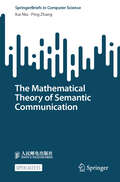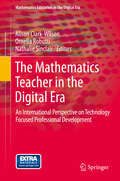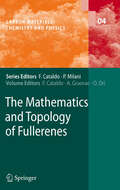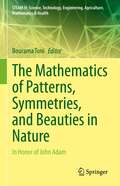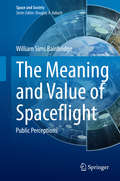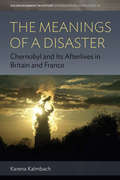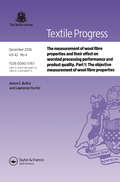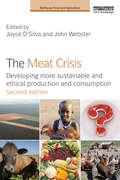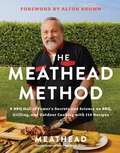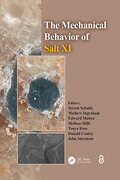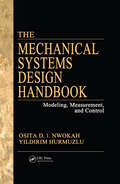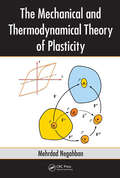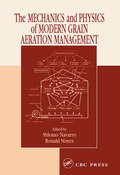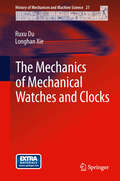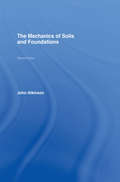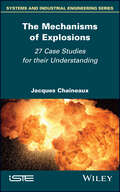- Table View
- List View
The Mathematical Theory of Semantic Communication (SpringerBriefs in Computer Science)
by Ping Zhang Kai NiuThis Open Access Book explores how classical information theory&’s focus on syntactic information has limited the further development of communication science. Recently, communication technologies that handle and transmit semantic information have gained widespread attention in academia. Semantic communication has paved new directions for the future of communication technology development, yet it lacks a general mathematical guiding theory. To address this challenge, this open access book constructs a theoretical framework for semantic information theory and provides a systematic exposition of the measurement system for semantic information and the theoretical limits of semantic communication. It serves as a professional reference for researchers in information and communication. The book begins by deeply analyzing the data characteristics of various information sources and the needs of downstream tasks to summarize and generalize the universal attribute of semantic information—synonymity and to define the synonymous mapping between semantic information and syntactic information. Stemming from this core concept, synonymous mapping, this book introduces the measures of semantic information. It then introduces a new mathematical tool, Synonymous Asymptotic Equipartition (AEP), to explore the mathematical properties of synonymous typical sequences and applies random coding and synonymous typical sequence decoding/encoding to prove the semantic lossless source coding theorem, semantic channel coding theorem, and semantic limited distortion source coding theorem. In addition, the semantic information measures in the continuous case are discussed and a new channel capacity formula of the band-limited Gaussian channel is obtained, which is an important extension of the classical channel capacity. The book is a valuable resource for researchers, academics, and professionals in the field of information and communication, particularly those interested in advancing the frontiers of semantic communication technology.
The Mathematics Teacher in the Digital Era: An International Perspective on Technology Focused Professional Development (Mathematics Education in the Digital Era #2)
by Nathalie Sinclair Alison Clark-Wilson Ornella RobuttiThis volume addresses the key issue of the initial education and lifelong professional learning of teachers of mathematics to enable them to realize the affordances of educational technology for mathematics. With invited contributions from leading scholars in the field, this volume contains a blend of research articles and descriptive texts.In the opening chapter John Mason invites the reader to engage in a number of mathematics tasks that highlight important features of technology-mediated mathematical activity. This is followed by three main sections:An overview of current practices in teachers’ use of digital technologies in the classroom and explorations of the possibilities for developing more effective practices drawing on a range of research perspectives (including grounded theory, enactivism and Valsiner’s zone theory).A set of chapters that share many common constructs (such as instrumental orchestration, instrumental distance and double instrumental genesis) and research settings that have emerged from the French research community, but have also been taken up by other colleagues.Meta-level considerations of research in the domain by contrasting different approaches and proposing connecting or uniting elements
The Mathematics and Topology of Fullerenes
by Franco Cataldo Ottorino Ori Ante GraovacThe Mathematics and Topology of Fullerenes presents a comprehensive overview of scientific and technical innovations in theoretical and experimental studies. Topics included in this multi-author volume are: Clar structures for conjugated nanostructures; counting polynomials of fullerenes; topological indices of fullerenes; the wiener index of nanotubes; toroidal fullerenes and nanostars; C60 Structural relatives: a topological study; local combinatorial characterization of fullerenes; computation of selected topological indices of C60 and C80 Fullerenes via the Gap Program; 4valent- analogues of fullerenes; a detailed atlas of Kekule structures of C60. The Mathematics and Topology of Fullerenes is targeted at advanced graduates and researchers working in carbon materials, chemistry and physics.
The Mathematics of Mechanobiology: Cetraro, Italy 2018 (Lecture Notes in Mathematics #2260)
by Benoît Perthame Alfio Quarteroni Lev Truskinovsky Antonio DeSimoneThis book presents the state of the art in mathematical research on modelling the mechanics of biological systems – a science at the intersection between biology, mechanics and mathematics known as mechanobiology. The book gathers comprehensive surveys of the most significant areas of mechanobiology: cell motility and locomotion by shape control (Antonio DeSimone); models of cell motion and tissue growth (Benoît Perthame); numerical simulation of cardiac electromechanics (Alfio Quarteroni); and power-stroke-driven muscle contraction (Lev Truskinovsky).Each section is self-contained in terms of the biomechanical background, and the content is accessible to all readers with a basic understanding of differential equations and numerical analysis. The book disentangles the phenomenological complexity of the biomechanical problems, while at the same time addressing the mathematical complexity with invaluable clarity. The book is intended for a wide audience, in particular graduate students and applied mathematicians interested in entering this fascinating field.
The Mathematics of Patterns, Symmetries, and Beauties in Nature: In Honor of John Adam (STEAM-H: Science, Technology, Engineering, Agriculture, Mathematics & Health)
by Bourama ToniThis unique book gathers various scientific and mathematical approaches to and descriptions of the natural and physical world stemming from a broad range of mathematical areas – from model systems, differential equations, statistics, and probability – all of which scientifically and mathematically reveal the inherent beauty of natural and physical phenomena. Topics include Archimedean and Non-Archimedean approaches to mathematical modeling; thermography model with application to tungiasis inflammation of the skin; modeling of a tick-Killing Robot; various aspects of the mathematics for Covid-19, from simulation of social distancing scenarios to the evolution dynamics of the coronavirus in some given tropical country to the spatiotemporal modeling of the progression of the pandemic. Given its scope and approach, the book will benefit researchers and students of mathematics, the sciences and engineering, and everyone else with an appreciation for the beauty of nature. The outcome is a mathematical enrichment of nature’s beauty in its various manifestations. This volume honors Dr. John Adam, a Professor at Old Dominion University, USA, for his lifetime achievements in the fields of mathematical modeling and applied mathematics. Dr. Adam has published over 110 papers and authored several books.
The Matter of the Heart: A History of the Heart in Eleven Operations
by Thomas Morris“More than a litany of medical advances—it’s the story of the gritty, bloody and deadly experiences that underlie scientific progress.” —Washington PostAn eye-opening and heroic story of pioneering heart surgeons, structured around eleven operations.For thousands of years the human heart remained the deepest of mysteries; both home to the soul and an organ too complex to touch, let alone operate on.Then, in the late nineteenth century, medics began going where no one had dared go before. The following decades saw the mysteries of the heart exposed, thanks to pioneering surgeons, brave patients and even sacrificial dogs.In eleven landmark operations, Thomas Morris tells us stories of triumph, reckless bravery, swaggering arrogance, jealousy and rivalry, and incredible ingenuity: the trail-blazing ‘blue baby’ procedure that transformed wheezing infants into pink, healthy children; the first human heart transplant, which made headline news around the globe. And yet the heart still feels sacred: just before the operation to fit one of the first artificial hearts, the patient’s wife asked the surgeon if he would still be able to love her.The Matter of the Heart gives us a view over the surgeon’s shoulder, showing us the heart’s inner workings and failings. It describes both a human story and a history of risk-taking that has ultimately saved millions of lives.“A thoroughly engaging history.” —The Wall Street Journal“Morris’s expert guided tour of cardiac surgery and its quirky, brilliant innovators covers a dazzling and dizzying array of procedures and hints at tantalizing prospects for future surprises.” —Publishers Weekly, starred review“A well-developed narrative with no end of heroes.’“ —Kirkus Reviews“Gripping.” —John Crace, The Guardian
The Meaning and Value of Spaceflight
by William Sims BainbridgeThis book presents the most serious and comprehensive study, by far, of American public perceptions about the meaning of space exploration, analyzing vast troves of questionnaire data collected by many researchers and polling firms over a span of six decades and anchored in influential social science theories. It doesn't simply report the percentages who held various opinions, but employs sophisticated statistical techniques to answer profound questions and achieve fresh discoveries. Both the Bush and the Obama administrations have cut back severely on fundamental research in space science and engineering. Understanding better what space exploration means for citizens can contribute to charting a feasible but progressive course. Since the end of the Space Race between the US and the USSR, social scientists have almost completely ignored space exploration as a topic for serious analysis and this book seeks to revive that kind of contribution. The author communicates the insights in a lucid style, not only intelligible but interesting to readers from a variety of backgrounds.
The Meaning of Liberty Beyond Earth
by Charles S. CockellThe purpose of this book is to initiate a new discussion on liberty focusing on the infinite realms of space. The discussion of the nature of liberty and what it means for a human to be free has occupied the minds of thinkers since the Enlightenment. However, without exception, every one of these discussions has focused on the character of liberty on the Earth. The emergence of human space exploration programs in the last 40-50 years raise a fundamental and new question: what will be the future of liberty in space? This book takes the discussion of liberty into the extraterrestrial environment. In this book, new questions will be addressed such as: Can a person be free when the oxygen the individual breathes is the result of a manufacturing process controlled by someone else? Will the interdependence required to survive in the extremities of the extraterrestrial environment destroy individualism? What are the obligations of the individual to the extraterrestrial state? How can we talk of extraterrestrial liberty when everyone is dependent on survival systems?
The Meanings of a Disaster: Chernobyl and Its Afterlives in Britain and France (Environment in History: International Perspectives #20)
by Karena KalmbachThe disaster at the Chernobyl nuclear power plant was an event of obviously transnational significance—not only in the airborne particulates it deposited across the Northern hemisphere, but in the political and social repercussions it set off well beyond the Soviet bloc. Focusing on the cases of Great Britain and France, this innovative study explores the discourses and narratives that arose in the wake of the incident among both state and nonstate actors. It gives a thorough account of the stereotypes, framings, and “othering” strategies that shaped Western European nations’ responses to the disaster, and of their efforts to come to terms with its long-term consequences up to the present day.
The Measurement of Grain Boundary Geometry
by Valerie RandleAs the selection of material for particular engineering properties becomes increasingly important in keeping costs down, methods for evaluating material properties also become more relevant. One such method examines the geometry of grain boundaries, which reveals much about the properties of the material.Studying material properties from their geometrical measurements, The Measurement of Grain Boundary Geometry provides a framework for a specialized application of electron microscopy for metals and alloys and, by extension, for ceramics, minerals, and semiconductors. The book presents an overview of the developments in the theory of grain boundary geometry and its practical applications in material engineering. It also covers the tunneling electron microscope (TEM), experimental aspects of data collection, data processing, and examples from actual investigations. Each step of the analysis process is clearly described, from data collection through processing, analysis, representation, and display to applications. The book also includes a glossary of terms.Exploring both the experimental and analytical aspects of the subject, this practical reference guide is essential for researchers and students involved in material properties, whether in physics, materials science, metallurgy, or physical chemistry.
The Measurement of Roundwood: Methodologies and Conversion Ratios
by M. A. FonsecaThe ability to measure roundwood quantity and quality, and predict product yields is of great importance to forest industries. However, roundwood metrics is a topic that is often difficult to understand due to counter-intuitive trends, inconsistencies and variability in a number of factors. This book provides a comprehensive guide to the various methods by which roundwood and the products of roundwood are measured. It presents and compares many different log scaling methods in terms of procedures and conversion ratios. Other topics covered include grading logs, log manufacturing quality, statistical sampling methods for determining log yard inventories and mill log usage volume. Detailed tables of data are presented for the main commercial timber species of the world.
The Measurement of Wool Fibre Properties and their Effect on Worsted Processing Performance and Product Quality: Part 1: The Objective Measurement of Wool Fibre Properties
by Anton F. Botha; Lawrance HunterA critical and comprehensive examination of the origination and application of developments in the textile industry and its products, this book provides one of the only state-of-the-science reviews carried out in recent years. It covers the measurement of wool fiber properties, specifically those of raw wool. It also examines the release and wide acceptance of instrument and test methods for the most important wool fiber characteristics both cost-effectively and rapidly.
The Meat Crisis: Developing more Sustainable and Ethical Production and Consumption (Earthscan Food and Agriculture)
by John Webster Joyce D'SilvaMeat and dairy production and consumption are in crisis. Globally, 70 billion farm animals are used for food production every year. It is well accepted that livestock production is a major contributor to greenhouse gas emissions. The Food and Agriculture Organization of the United Nations (FAO) predicts a rough doubling of meat and milk consumption in the first half of the 21st century, with particularly rapid growth occurring in the developing economies of Asia. What will this mean for the health and wellbeing of those animals, of the people who consume ever larger quantities of animal products, and for the health of the planet itself? The new edition of this powerful and challenging book explores the impacts of the global growth in the production and consumption of meat and dairy, including cultural and health factors, and the implications of the likely intensification of farming for both small-scale producers and for animals. Several chapters explore the related environmental issues, from resource use of water, cereals and soya, to the impact of livestock production on global warming and issues concerning biodiversity, land use and the impacts of different farming systems on the environment. A final group of chapters addresses ethical and policy implications for the future of food and livestock production and consumption. Since the first edition, published in 2010, all chapters have been updated, three original chapters re-written and six new chapters added, with additional coverage of dietary effects of milk and meat, antibiotics in animal production, and the economic, political and ethical dimensions of meat consumption. The overall message is clearly that we must eat less meat to help secure a more sustainable and equitable world.
The Meathead Method: A BBQ Hall of Famer's Secrets and Science on BBQ, Grilling, and Outdoor Cooking with 114 Recipes
by Meathead“The only book on outdoor cookery you’ll ever need.” —Alton BrownAmazon May 2025 Best of the Month PickThe Meathead Method is where barbecue goes next. In the follow-up to his New York Times bestseller Meathead: The Science of Great Barbecue and Grilling, BBQ Hall of Famer and founder of AmazingRibs.com, Meathead presents a guide to new methods for great outdoor cooking with 114 creative and inspiring recipes. The Meathead Method is a toolbox to elevate all your cooking, outdoors and indoors.Learn the basics of great barbecue, grilling, and griddling plus new methods and science not covered in his first book (or any other): brinerades; sous vide que; koji; wok cooking on a charcoal chimney; smoking with tea, herbs, and spices; building your own rubs and sauces; why foods stick to metal; how to safely deep fry on a gas grill; how enzymes work; dry brining; the inverse square law; the hockey stick; 2- and 3-zone setups; the reverse sear; how to beat the stall; the Smoking Gun; injections; why butter basting doesn’t work the way you think it does; neither does beer can chicken; nor do marinades; ponassing and spatchcocking (get your mind out of the gutter); and much more!You’ll also learn how to use out-of-the-BBQ-box ingredients like black garlic, gochujang, yuzu, miso, zhug, and tare sauce, and recipes showcasing Meathead’s methods, including: The secret recipes of competition championsThe Ultimate Prime RibPho with Leftover Brisket and Smoked Bone BrothMussels on Smoked FettucineMiso Maple Black Cod à la NobuVichyssoiseImproved Nashville Hot ChickenRed Pepper RisottoPineapple Foster
The Mechanical Behavior of Salt X: PROCEEDINGS OF THE 10TH CONFERENCE ON THE MECHANICAL BEHAVIOR OF SALT (SALTMECH X), UTRECHT, THE NETHERLANDS, 06-08 JULY 2022
by J.H.P. de BresserRock salt formations have long been recognized as a valuable resource - not only for salt mining but for construction of oil and gas storage caverns and for isolation of radioactive and other hazardous wastes. Current interest is fast expanding towards construction and re-use of solution-mined caverns for storage of renewable energy in the form of hydrogen, compressed air and other gases. Evaluating the long term performance and safety of such systems demands an understanding of the coupled mechanical behavior and transport properties of salt. This volume presents a collection of 60 research papers defining the state-of-the-art in the field. Topics range from fundamental work on deformation mechanisms and damage of rock salt to compaction of engineered salt backfill. The latest constitutive models are applied in computational studies addressing the evolution and integrity of storage caverns, repositories, salt mines and entire salt formations, while field studies document ground truth at multiple scales. The volume is structured into seven themes: Microphysical processes and creep models Laboratory testing Geological isolation systems and geotechnical barriers Analytical and numerical modelling Monitoring and site-specific studies Cavern and borehole abandonment and integrity Energy storage in salt caverns The Mechanical Behavior of Salt X will appeal to graduate students, academics, engineers and professionals working in the fields of salt mechanics, salt mining and geological storage of energy and wastes, but also to researchers in rock physics in general.
The Mechanical Behavior of Salt XI
by Steven R. SobolikRock salt formations have long been recognized as a valuable resource - not only for salt mining but for construction of oil and gas storage caverns and for isolation of radioactive and other hazardous wastes. Current interest is fast expanding towards construction and re-use of solution-mined caverns for storage of renewable energy in the form of hydrogen, compressed air and other gases. Evaluating the long-term performance and safety of such systems demands an understanding of the coupled mechanical behavior and transport properties of salt. This volume presents a collection of 83 research papers defining the state-of-the-art in the field. Topics range from fundamental work on deformation mechanisms and damage of rock salt to compaction of engineered salt backfill. The latest constitutive models are applied in computational studies addressing the evolution and integrity of storage caverns, repositories, salt mines and entire salt formations, while field studies document in situ salt behavior and conditions at multiple scales. The volume is structured into ten themes:• Laboratory Testing• Field and Geological Investigations• Constitutive Modeling• Modeling and Simulation• Micromechanics and Microstructures• Salt Caverns, Cavern Abandonment & Long-Term Integrity• Crushed Salt Engineered Barriers• Geological and Engineered Barriers• Energy Storage and Mining Investigations• Geological Storage of HydrogenThe Mechanical Behavior of Salt XI will appeal to graduate students, academics, engineers and professionals working in the fields of salt mechanics, salt mining and geological storage of energy and wastes, but also to researchers in rock physics in general.
The Mechanical Behavior of Salt – Understanding of THMC Processes in Salt: Proceedings of the 6th Conference (SaltMech6), Hannover, Germany, 22–25 May 2007
by Manfred Wallner Karl-Heinz Lux Wolfgang Minkley H. Reginald HardyA unique opportunity to review the latest progress in an expanding area of interest: the Mechanical Behaviour of Salt. These Proceedings include over fifty papers and summaries describing the latest findings in ongoing studies from a number of research groups. For the 2007 conference, there was a particular focus on the understanding of thermal, mechanical, hydraulic and chemical coupled processes (THMC). Such processes are of specific interest when considering advanced problems in waste disposal, storage and mining. The book includes a number of themes: - laboratory and in-situ investigations modelling, e.g. derivation of constitutive equations - numerical computations and prediction of long-term behaviour - THMC processes in mining projects, storage and permanent disposal - case studies - geology - mining and storage applications and abandonment The International Conferences on the Mechanical Behaviour of Salt have a long tradition, being initiated in 1981 at The Pennsylvania State University, USA. The present conference, the sixth of the series, took place in Hannover, Germany, in May 2007. The conference brought together mining engineers, researchers, and university professors interested in the mechanical behaviour of salt, mostly from Europe and beyond.
The Mechanical Systems Design Handbook: Modeling, Measurement, and Control (Electrical Engineering Handbook)
by Osita D. I. Nwokah Yildirim HurmuzluWith a specific focus on the needs of the designers and engineers in industrial settings, The Mechanical Systems Design Handbook: Modeling, Measurement, and Control presents a practical overview of basic issues associated with design and control of mechanical systems. In four sections, each edited by a renowned expert, this book answers diverse questions fundamental to the successful design and implementation of mechanical systems in a variety of applications.Manufacturing addresses design and control issues related to manufacturing systems. From fundamental design principles to control of discrete events, machine tools, and machining operations to polymer processing and precision manufacturing systems.Vibration Control explores a range of topics related to active vibration control, including piezoelectric networks, the boundary control method, and semi-active suspension systems.Aerospace Systems presents a detailed analysis of the mechanics and dynamics of tensegrity structuresRobotics offers encyclopedic coverage of the control and design of robotic systems, including kinematics, dynamics, soft-computing techniques, and teleoperation.Mechanical systems designers and engineers have few resources dedicated to their particular and often unique problems. The Mechanical Systems Design Handbook clearly shows how theory applies to real world challenges and will be a welcomed and valuable addition to your library.
The Mechanical and Thermodynamical Theory of Plasticity
by Mehrdad NegahbanBorn out of 15 years of courses and lectures on continuum mechanics, nonlinear mechanics, continuum thermodynamics, viscoelasticity, plasticity, crystal plasticity, and thermodynamic plasticity, The Mechanical and Thermodynamical Theory of Plasticity represents one of the most extensive and in-depth treatises on the mechanical and thermodynamical a
The Mechanics and Physics of Modern Grain Aeration Management
by Shlomo Navarro Ronald NoyesThe tightening of health and environmental regulations by banning chemical pesticides has generated the need for alternative technologies to solve grain storage problems. Aeration is such an option that can be applied to stored grain and a wide range of agricultural commodities to control insects and maintain quality. The Mechanics and Physics of M
The Mechanics of Jointed Structures
by Matthew R. W. BrakeThis book introduces the challenges inherent in jointed structures and guides researchers to the still-open, pressing challenges that need to be solved to advance this critical field. The authors cover multiple facets of interfacial mechanics that pertain to jointed structures: tribological modeling and measurements of the interface surfaces, constitutive modeling of joints, numerical reduction techniques for structures with joints, and uncertainty quantification and propagation for these structures. Thus, the key subspecialties addressed are model reduction for nonlinear systems, uncertainty quantification, constitutive modeling of joints, and measurements of interfacial mechanics properties (including tribology). The diverse contributions to this volume fill a much needed void in the literature and present to a new generation of joints researchers the potential challenges that they can engage in in order to advance the state of the art. Clearly defines internationally recognized challenges in joint mechanics/jointed structures and provides a comprehensive assessment of the state-of-the-art for joint modeling; Identifies open research questions facing joint mechanics; Details methodologies for accounting for uncertainties (due both to missing physics and variability) in joints; Explains and illustrates best-practices for measuring joints' properties experimentally; Maximizes reader understanding of modeling joint dynamics with a comparison of multiple approaches.
The Mechanics of Mechanical Watches and Clocks
by Longhan Xie Ruxu Du"The Mechanics of Mechanical Watches and Clocks" presents historical views and mathematical models of mechanical watches and clocks. Although now over six hundred years old, mechanical watches and clocks are still popular luxury items that fascinate many people around the world. However few have examined the theory of how they work as presented in this book. The illustrations and computer animations are unique and have never been published before. It will be of significant interest to researchers in mechanical engineering, watchmakers and clockmakers, as well as people who have an engineering background and are interested in mechanical watches and clocks. It will also inspire people in other fields of science and technology, such as mechanical engineering and electronics engineering, to advance their designs. Professor Ruxu Du works at the Chinese University of Hong Kong, China. Assistant Professor Longhan Xie works at the South China University of Technology, China.
The Mechanics of Robot Grasping
by Elon Rimon Joel BurdickIn this comprehensive textbook about robot grasping, readers will discover an integrated look at the major concepts and technical results in robot grasp mechanics. A large body of prior research, including key theories, graphical techniques, and insights on robot hand designs, is organized into a systematic review, using common notation and a common analytical framework. With introductory and advanced chapters that support senior undergraduate and graduate level robotics courses, this book provides a full introduction to robot grasping principles that are needed to model and analyze multi-finger robot grasps, and serves as a valuable reference for robotics students, researchers, and practicing robot engineers. Each chapter contains many worked-out examples, exercises with full solutions, and figures that highlight new concepts and help the reader master the use of the theories and equations presented.
The Mechanics of Soils and Foundations
by John AtkinsonIdeal for undergraduates of geotechnical engineering for civil engineers, this established textbook sets out the basic theories of soil mechanics in a clear and straightforward way; combining both classical and critical state theories and giving students a good grounding in the subject which will last right through into a career as a geotechnical engineer. The subject is broken down into discrete topics which are presented in a series of short, focused chapters with clear and accessible text that develops from the purely theoretical to discussing practical applications. Soil behaviour is described by relatively simple equations with clear parameters while a number of worked examples and simple experimental demonstrations are included to illustrate the principles involved and aid reader understanding.
The Mechanisms of Explosions: 27 Case Studies for their Understanding
by Jacques ChaineauxThe risk of explosion is inseparable from industrial activity, as we are often reminded by the news. In order to avoid an explosion, it is necessary to understand the phenomena surrounding it, and take the necessary preventive measures to protect society if it comes to the worst-case scenario. This book will detail these phenomena. The Mechanisms of Explosions presents theoretical aspects from a physicochemical point of view and proposes various methods adapted to each type of explosion, including ATEX explosions. The author shares his knowledge of the mechanisms of explosions, acquired during numerous investigations. These 27 case studies – detailing circumstances, mechanisms and the nature and intensity of explosive effects – were selected to cover all of the possible physical or chemical phenomena, substances and mechanisms, without limiting themselves to the most common situations. This book, packed full of information, is designed to benefit those who analyze and investigate explosions, particularly insurance and judicial experts, prevention engineers, security managers and trainers.
